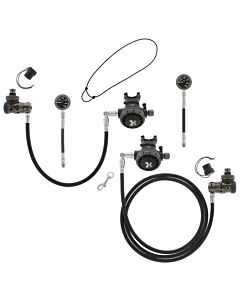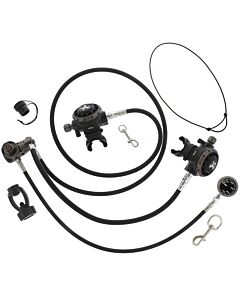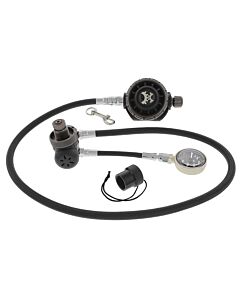DGX Gears XTRA Regulator
These DGX Custom regulator packages are fully assembled and integrated by Dive Gear Express using DGX Gears XTRA first and second stage regulators together with our premium quality hoses, gauges, adapters, stainless steel hardware and other regulator accessories.
-
 DGX Custom - DGX Gears XTRA RegulatorStarting at $449.00
DGX Custom - DGX Gears XTRA RegulatorStarting at $449.00 -
 DGX Custom - DGX Gears XTRA Sidemount Reg PackageStarting at $799.00
DGX Custom - DGX Gears XTRA Sidemount Reg PackageStarting at $799.00 -
 DGX Gears XTRA 1st Stage$274.00
DGX Gears XTRA 1st Stage$274.00 -
 DGX Gears XTRA 2nd Stage$174.00
DGX Gears XTRA 2nd Stage$174.00 -
 Service Kit - DGX Gears XTRA RegulatorsSelect Kit to See Price
Service Kit - DGX Gears XTRA RegulatorsSelect Kit to See Price
Environmentally Sealing SCUBA Regulators
All balanced first stages compensate for depth; which means there must be a chamber exposed to ambient water pressure. The reason for sealing the chamber is mostly to improve resistance to forming ice inside the chamber when diving in near freezing temperatures. An environmental seal also has the potential to reduce corrosion inside the chamber. However, properly rinsing any regulator after diving should eliminate concerns about corrosion. The anti-icing benefit tradeoff on any regulator design is to increase complexity thus theoretically decreasing reliability and in some designs also increasing the need for more frequent periodic service.
Balanced diaphragm first stage designs have an ambient pressure chamber containing moving parts. Environmentally sealed means there is a very flexible silicone or rubber disk covering the chamber containing the transmitter and spring assembly so they remain dry yet still allow depth compensation. Many balanced diaphragm regulators are now offering environmentally sealed versions because it has recently become a widely promoted feature. However, the Poseidon first stage is not environmentally sealed and yet the Xstream is famous for its extreme resistance to icing; tested in salt water to { 29 °F | -2 °C} the anti-icing diaphragm design relies upon flowing water through its open balance chamber.
Balanced piston first stage designs are not typically described as environmentally sealed in the conventional sense because the internals are protected by other methods inherent in their design. However, to improve resistance to icing in near freezing water temperatures, historically some divers filled the ambient pressure balance chamber with a high viscosity lubricant. This is an inconvenient and messy practice that is less common today as modern piston designs rated specifically for ice diving have better methods to protect against ice formation.
There are a great many non-sealed regulators in use today that with proper care have provided decades of reliable and corrosion free service. The bottom line is that unless you are diving in near freezing water, there is no strong reason to prefer an environmentally sealed first stage.









